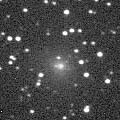
|
Already bright as 11.1 mag (June 5, Juan Jose Gonzalez). It is brightening rapidly now, and will reach to 9 mag in July. However, it moves southwards very fast in August. It is only observable until mid August in the Northern Hemisphere. On the other hand, it keeps low and hard to observe until mid July in the Southern Hemisphere.
Date(TT) R.A. (2000) Decl. Delta r Elong. m1 Best Time(A, h)
June 9 23 8.31 45 46.6 1.362 1.450 73 11.6 3:00 (239, 54)
June 16 22 54.16 50 39.6 1.152 1.374 78 11.0 2:58 (228, 60)
|
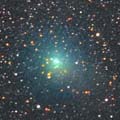
|
It passed near by the earth in mid April, and reached to 7.6 mag (Apr. 18, Juan Jose Gonzalez). It locates high in the evening sky, and it is observable in good condition. But it already faded won to 11.3 mag (May 26, Seiichi Yoshida). It keeps observable in good condition in the Northern Hemisphere until the comet has gone. It will be visible visually until July.
Date(TT) R.A. (2000) Decl. Delta r Elong. m1 Best Time(A, h)
June 9 13 46.00 63 53.0 1.325 1.596 84 11.3 20:58 (175, 61)
June 16 13 29.98 62 55.8 1.492 1.672 81 11.8 21:02 (164, 60)
|
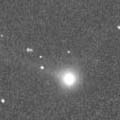
|
It had been observed while brightening rapidly until the perihelion passage on Apr. 19, although it located extremely low in the evening sky. It reached to 6.7 mag on Apr. 17 (Juan Jose Gonzalez). In the Southern Hemisphere, it appeared in the morning sky at 7.8 mag in early May (May 9, Alexandre Amorim). Now it is 8.6 mag (May 11, Con Stoitsis). Then it is fading rapidly. Now it is 10.9 mag (May 27, Ken-ichi Kadota). It became observable also in the Northern Hemisphere again. But it locates only 20 degree high at most, and it will be fading rapidly.
Date(TT) R.A. (2000) Decl. Delta r Elong. m1 Best Time(A, h)
June 9 23 52.13 -23 6.6 0.521 1.134 89 11.7 3:00 (308, 11)
June 16 23 25.10 -26 25.6 0.528 1.241 102 12.4 2:58 (320, 16)
|
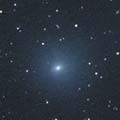
|
It passed near by the earth in early April, and reached to 8.7 mag (Apr. 10, Werner hasubick). Then it is fading gradually, and now it is 11.8 mag (May 26, Seiichi Yoshida). It is already low, and will be unobservable soon. It will appear in the morning sky again at 15 mag in August.
Date(TT) R.A. (2000) Decl. Delta r Elong. m1 Best Time(A, h)
June 9 7 20.23 23 30.6 2.075 1.308 30 11.8 20:58 (116, 4)
June 16 7 17.76 23 52.3 2.202 1.332 23 12.1 21:02 (121, -2)
|
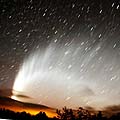
|
Excellent great comet, few times in a lifetime, for southern people. It reached to -5.5 mag on Jan. 14 and 15, brighter than Venus, and visible even in daytime. Then it appeared in the evening sky in the Southern Hemisphere and many people enjoyed a fantastic view of a beautiful great comet, a enormous curving tail with so many striae over 50 degrees. Now it is observable both in the evening and morning. It has already faded down to 10.9 mag (May 16, Walter Ruben Robledo). In the Southern Hemisphere, It keeps observable almost all night until the comet has gone. It will never be observable again in the Northern Hemisphere.
Date(TT) R.A. (2000) Decl. Delta r Elong. m1 Best Time(A, h)
June 9 10 8.00 -80 33.4 2.395 2.906 110 11.8 20:58 ( 9,-30)
June 16 10 48.58 -78 19.1 2.492 3.002 110 12.1 21:02 ( 11,-28)
|
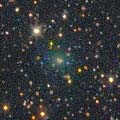
|
It became brighter than expected, and now it is visible visually at 13.2 mag (May 12, Carlos Labordena). However, it is already low in the evening sky, and it will be unobservable soon. It is not observable around the perihelion passage in July in conjunction with the sun. Then it moves to the southern sky, and it will be unobservable in the Northern Hemisphere.
Date(TT) R.A. (2000) Decl. Delta r Elong. m1 Best Time(A, h)
June 9 7 22.81 27 58.5 2.680 1.885 31 13.3 20:58 (119, 8)
June 16 7 40.84 25 57.2 2.690 1.861 28 13.2 21:02 (119, 4)
|
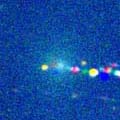
|
New comet discovered in the Southern Hemisphere. In the Southern Hemisphere, it is observable in the evening sky until early August while the comet is fading gradually down to 16 mag. In the Northern Hemisphere, it is not observable until when the comet becomes fainter than 18 mag. It was not discovered in last autumn when the comet located in the good condition, so it may fade out rapidly after this.
Date(TT) R.A. (2000) Decl. Delta r Elong. m1 Best Time(A, h)
June 9 6 58.71 -14 23.4 1.774 1.299 46 13.4 20:58 ( 87,-22)
June 16 7 31.93 -13 45.9 1.828 1.352 46 13.6 21:02 ( 88,-21)
|

|
It had been bright as 12-13 mag and visible visually almost always from 2006 July to 2007 April. However, now it is not observable. It will appear in the morning sky again in late July.
Date(TT) R.A. (2000) Decl. Delta r Elong. m1 Best Time(A, h)
June 9 5 6.47 29 25.5 6.925 5.917 6 14.0 3:00 (219,-13)
June 16 5 12.85 29 30.6 6.924 5.919 8 14.0 2:58 (223,-10)
|
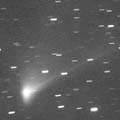
|
After the perihelion passage on Apr. 4, it appeared in the morning sky and it was so bright as 5.5 mag (Apr. 10, Michael Jager and Gerald Rhemann). Then it is fading rapidly. But it is bright as 12.8 mag still now (May 26, Seiichi Yoshida). Now the location is very good, so it will be bright for some more time.
Date(TT) R.A. (2000) Decl. Delta r Elong. m1 Best Time(A, h)
June 9 18 55.10 7 24.7 0.640 1.560 139 14.0 1:50 ( 0, 63)
June 16 18 16.00 2 57.3 0.702 1.668 151 14.6 0:43 ( 0, 58)
|
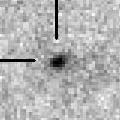
|
It appeared in the morning sky. It is bright as 14.7 mag (May 13, Ernesto Guido and Giovanni Sostero). It will be getting higher gradually after this, and it will keep bright as 15 mag and observable in good condition for a long time until autumn.
Date(TT) R.A. (2000) Decl. Delta r Elong. m1 Best Time(A, h)
June 9 1 24.20 19 8.3 2.541 2.072 51 14.6 3:00 (260, 19)
June 16 1 37.30 21 14.6 2.494 2.080 54 14.6 2:58 (260, 23)
|
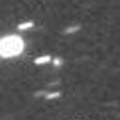
|
Now it is bright and visible visually at 14.1 mag (May 26, Seiichi Yoshida). It will be observable at 14.5 mag at high location from spring to summer both in 2007 and 2008.
Date(TT) R.A. (2000) Decl. Delta r Elong. m1 Best Time(A, h)
June 9 18 8.87 -4 43.2 4.873 5.818 156 14.7 1:03 ( 0, 50)
June 16 18 0.78 -4 8.2 4.840 5.804 159 14.7 0:27 ( 0, 51)
|
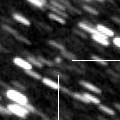
|
Now it is 15.8 mag (May 3, Tony Farkas), brightening as expected. It will reach to 14.5 mag in 2007 summer. However, it moves in the southen sky. In the Northern Hemisphere, it becomes unobservable in July.
Date(TT) R.A. (2000) Decl. Delta r Elong. m1 Best Time(A, h)
June 9 20 41.33 -36 6.4 2.831 3.591 132 14.8 3:00 (353, 19)
June 16 20 33.14 -38 50.5 2.728 3.561 139 14.7 2:58 ( 0, 16)
|

|
It will reach to 11 mag in 2008 spring. It will keep bright for a long time, however, it keeps moving in the southern sky for a while after this. In the Southern Hemisphere, now it is low temporarily. But it will be high after July, then it keeps observable in good condition until 2008 summer. In the Northern Hemisphere, it will appear at 13 mag in November in a short time, but very low and hard to observe. However, it will be visible visually at 11 mag in the evening sky from March to June in 2008. Then it becomes unobservable again. But it will appear in the morning sky again at 13 mag at the end of 2008, then it keeps bright and observable for a while.
Date(TT) R.A. (2000) Decl. Delta r Elong. m1 Best Time(A, h)
June 9 6 7.70 -26 10.3 5.274 4.706 51 15.1 20:58 ( 82,-38)
June 16 6 16.06 -26 3.5 5.237 4.655 50 15.1 21:02 ( 85,-43)
|
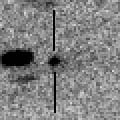
|
New periodic comet. Now it is bright as 15.2 mag (June 4, Ken-ichi Kadota). It will be observable in very good condition at 14 mag from summer to autumn. It may be visible visually. However, it was not discovered at the previous apparition in 1999. So it may be bright temporarily in outburst.
Date(TT) R.A. (2000) Decl. Delta r Elong. m1 Best Time(A, h)
June 9 23 22.10 -3 58.5 2.136 2.332 87 15.3 3:00 (300, 30)
June 16 23 31.55 -3 32.1 2.048 2.323 92 15.2 2:58 (303, 33)
|
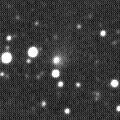
|
It kept 12 mag for over half a year since last June. It was still bright as 12.6 mag on Mar. 9 (Edwin van Dijk). But it has already started fading, and will be already too faint to see visually. However, the fading is slow. The comet will be fainter than 18 mag in 2008. In the Northern Hemisphere, it keeps observable until that time.
Date(TT) R.A. (2000) Decl. Delta r Elong. m1 Best Time(A, h)
June 9 4 26.59 66 40.6 3.716 3.072 44 15.2 3:00 (200, 20)
June 16 4 41.50 66 8.8 3.785 3.130 43 15.3 2:58 (201, 20)
|
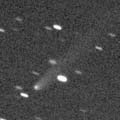
|
It has been visible at 13.5 mag for a long time since 2005 autumn until 2006 spring. It was still bright and visible visually as 14.2 mag in winter (Dec. 22, Seiichi Yoshida). However, it has already faded down to 16.4 mag (May 26, Ken-ichi Kadota). Fine tail is visible on CCD images. It will be getting lower gradually after June, and will be too low to observe in September.
Date(TT) R.A. (2000) Decl. Delta r Elong. m1 Best Time(A, h)
June 9 12 36.94 19 46.8 5.790 6.077 101 15.2 20:58 ( 59, 65)
June 16 12 37.41 19 1.4 5.915 6.104 95 15.3 21:02 ( 67, 59)
|
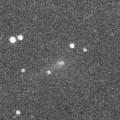
|
Originally considered as a peculiar asteroid, but revealed to be a comet. In the Southern Hemisphere, it became observable in late April. It approached to Sun down to 0.6 A.U. in late April, then it passed very near by Earth in May. It moved eastwards extremely fast, and it became observable in the evening sky on May 23 also in the Northeren Hemisphere. It keeps observable in the evening sky. It was predicted to fade out rapidly. However, it was 12.8 mag on May 24 (Alan Hale), 13.5-14.0 mag on June 6 (Michael Jager and Gerald Rhemann), so it is still bright. It is predicted to be fainter than 18 mag in late June. But it may be brighter than this ephemeris for a while.
Date(TT) R.A. (2000) Decl. Delta r Elong. m1 Best Time(A, h)
June 9 10 11.48 21 12.7 0.797 1.052 69 15.7 20:58 ( 91, 37)
June 16 10 32.86 20 43.2 1.058 1.162 68 16.6 21:02 ( 92, 35)
|
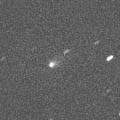
|
It is observable in good condition in the Southern Hemisphere, although it is already not observable in the Northern Hemisphere. It kept 13-14 mag for a long time since last autumn, and it was observed bright as 12.5 mag visually in April (Apr. 17, Michael Mattiazzo). Now it is fading, but it can be brighter than this ephemeris.
Date(TT) R.A. (2000) Decl. Delta r Elong. m1 Best Time(A, h)
June 9 15 24.53 -68 26.3 2.142 2.919 131 15.7 22:14 ( 0,-13)
June 16 15 21.05 -66 35.1 2.200 2.975 131 15.9 21:43 ( 0,-11)
|
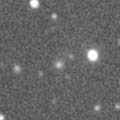
|
Now it brightened up to 15.8 mag (May 19, Ken-ichi Kadota). It keeps 15.5-16 mag for one year and a half after this until 2008 summer. However, because the comet moves southwards, it will be unobservable soon in the Northern Hemisphere.
Date(TT) R.A. (2000) Decl. Delta r Elong. m1 Best Time(A, h)
June 9 10 23.71 -3 51.7 3.184 3.199 81 15.8 20:58 ( 65, 25)
June 16 10 28.48 -4 43.8 3.238 3.161 76 15.7 21:02 ( 70, 19)
|
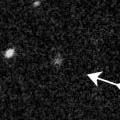
|
It will reach to 10.5 mag and will be observable in good condition in 2008 autumn. Now it is 16.0 mag (May 22, Ken-ichi Kadota), brightening as expected. It keeps observable in good condition for a long time while the comet is getting brighter slowly.
Date(TT) R.A. (2000) Decl. Delta r Elong. m1 Best Time(A, h)
June 9 22 8.75 -10 36.3 4.854 5.246 107 15.9 3:00 (322, 36)
June 16 22 8.84 -10 14.8 4.697 5.192 113 15.8 2:58 (329, 39)
|
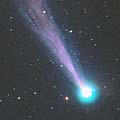
|
It reached up to 4 mag in 2006 autumn. But it had faded down to 10.5 mag on Jan. 11 (Carlos Labordena). It had been unobservable for a long time since that, but now it is appearing at dawn again. Now it is 16.8 mag (May 27, Ken-ichi Kadota), fading rather rapidly. After this, it keeps observable until it becomes fainter than 18 mag in autumn.
Date(TT) R.A. (2000) Decl. Delta r Elong. m1 Best Time(A, h)
June 9 23 3.80 -15 4.2 3.526 3.777 96 15.9 3:00 (312, 25)
June 16 23 1.89 -16 13.9 3.482 3.854 103 16.0 2:58 (319, 28)
|
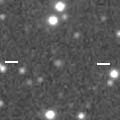
|
Now it is 17.3 mag (June 2, Ken-ichi Kadota). It will reach to 12 mag in 2008 summer. In the Northern Hemisphere, it keeps observable almost all time until that while the comet is brightening gradually. However, it goes to the southern sky and will never be observable again in the Northern Hemisphere after that.
Date(TT) R.A. (2000) Decl. Delta r Elong. m1 Best Time(A, h)
June 9 17 26.41 35 44.3 5.111 5.703 121 16.6 0:20 (180, 89)
June 16 17 19.71 35 20.8 5.057 5.651 121 16.5 23:41 (180, 90)
|
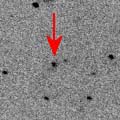
|
Now it is 17.2 mag (May 22, Ken-ichi Kadota). It will be observable at 16.5-17 mag in good condition in summer.
Date(TT) R.A. (2000) Decl. Delta r Elong. m1 Best Time(A, h)
June 9 20 50.08 12 15.1 5.355 5.857 114 16.8 3:00 (334, 65)
June 16 20 45.04 13 11.0 5.266 5.855 121 16.8 2:58 (352, 68)
|

|
Not yet observed in this return. But it should have already brightened up to 17 mag. It will be observable at 16.5 mag in summer and autumn in 2007, and observable at 17 mag in summer and autumn in 2008.
Date(TT) R.A. (2000) Decl. Delta r Elong. m1 Best Time(A, h)
June 9 17 56.23 -26 49.9 1.795 2.796 168 17.0 0:50 ( 0, 28)
June 16 17 50.25 -26 37.5 1.753 2.766 175 16.8 0:16 ( 0, 28)
|

|
Now it is 16.7 mag (May 27, Ken-ichi Kadota). It is outside of Jupiter's orbit. So it keeps 17 mag for a long time until 2007 summer. It keeps locating high and observable in good condition for a long time after this because it moves in the northern sky.
Date(TT) R.A. (2000) Decl. Delta r Elong. m1 Best Time(A, h)
June 9 13 45.32 36 30.6 7.173 7.483 103 16.9 20:58 (109, 85)
June 16 13 42.90 35 37.7 7.269 7.502 99 16.9 21:02 ( 97, 78)
|
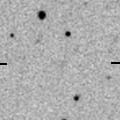
|
Now it is 18.2 mag (May 4, Ken-ichi Kadota). It will approach down to 0.4 A.U. to the sun on Oct. 28, and it is expected to reach to 6 mag. However, the condition in the Northern Hemisphere is very hard. It will be getting lower in the evening sky after this. The altitude becomes lower than 20 degree in early July, and lower than 10 degree in late July. The comet is still faint as 15.5 mag at that time. After conjunction with the sun, the comet will be brighter than 11 mag in late September, and will be 8 mag in mid October. But it locates extremely low, slightly over the horizon in the morning sky. It goes to the southern sky in late October, then it will never be observable again. In the Southern Hemisphere, it becomes unobservable in July. But it will appear in the evening sky at 7 mag in early November. Then it keeps observable while fading gradually, although it will not locate very high.
Date(TT) R.A. (2000) Decl. Delta r Elong. m1 Best Time(A, h)
June 9 10 3.52 29 0.8 2.893 2.647 65 17.0 20:58 (101, 39)
June 16 10 3.59 29 1.6 2.909 2.550 59 16.9 21:02 (105, 32)
|

|
Now it is 18.1 mag (Apr. 14, Maciej Reszelski). It is observable at 17.5-18 mag until autumn. It was discovered at 18 mag in 2006. It is a distant periodic comet, and it keeps observable at 18 mag for 4 years until 2009.
Date(TT) R.A. (2000) Decl. Delta r Elong. m1 Best Time(A, h)
June 9 19 15.24 -11 6.8 3.297 4.186 147 17.4 2:08 ( 0, 44)
June 16 19 12.02 -11 24.9 3.245 4.183 154 17.4 1:38 ( 0, 44)
|
|
![]()
 P/2007 H1 ( McNaught )
P/2007 H1 ( McNaught ) C/2006 L2 ( McNaught )
C/2006 L2 ( McNaught ) C/2003 WT42 ( LINEAR )
C/2003 WT42 ( LINEAR ) C/2006 WD4 ( Lemmon )
C/2006 WD4 ( Lemmon ) C/2005 YW ( LINEAR )
C/2005 YW ( LINEAR ) C/2006 V1 ( Catalina )
C/2006 V1 ( Catalina ) C/2006 OF2 ( Broughton )
C/2006 OF2 ( Broughton ) C/2006 M4 ( SWAN )
C/2006 M4 ( SWAN ) C/2007 G1 ( LINEAR )
C/2007 G1 ( LINEAR ) C/2005 S4 ( McNaught )
C/2005 S4 ( McNaught ) 44P/Reinmuth 2
44P/Reinmuth 2 C/2002 VQ94 ( LINEAR )
C/2002 VQ94 ( LINEAR ) C/2007 F1 ( LONEOS )
C/2007 F1 ( LONEOS ) P/2006 F1 ( Kowalski )
P/2006 F1 ( Kowalski )![]()























